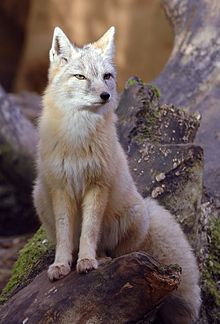Corsac fox
| Corsac fox | |
|---|---|
 |
|
| Scientific classification | |
| Kingdom: | Animalia |
| Phylum: | Chordata |
| Class: | Mammalia |
| Order: | Carnivora |
| Family: | Canidae |
| Genus: | Vulpes |
| Species: | V. corsac |
| Binomial name | |
|
Vulpes corsac Linnaeus, 1768 |
|
 |
|
| Corsac fox range | |
The corsac fox (Vulpes corsac), also known simply as a corsac, is a medium-sized fox found in steppes, semi-deserts and deserts in Central Asia, ranging into Mongolia and northeastern China. Since 2004, it has been classified as least concern by IUCN, but populations fluctuate significantly, and numbers can drop tenfold within a single year.
It is also known as the steppe fox, and sometimes referred to as the "sand fox", but this terminology is confusing because two other species, the Tibetan sand fox and Rüppell's fox are also sometimes known by this name. The word "corsac" is derived from the Russian name for the animal, "korsák" (корса́к). The corsac fox is threatened by hunting for the fur trade.
The corsac fox is a medium-sized fox, with a head and body length of 45 to 65 cm (18 to 26 in), and a tail 19 to 35 cm (7.5 to 13.8 in) long. Adults weigh from 1.6 to 3.2 kilograms (3.5 to 7.1 lb). It has grey to yellowish fur over much of the body, with paler underparts and pale markings on the mouth, chin, and throat. During the winter, the coat becomes much thicker and silkier in texture, and is straw-grey in colour, with a darker line running down the back.
For a fox, it has small teeth and a wide skull. One source claims that this species can climb trees and has been domesticated in the past. It is reported to have keen eyesight and hearing and an acute sense of smell. It has a number of scent glands, some of which produce pungent odours, although not as extreme as those found in some other Vulpes species. The glands are found in the anal region, above the base of the tail, and on the paws and cheeks.
Corsac foxes are reported to bark during hunting or when threatening rivals, and to use higher pitch yelps or chirps as alarm calls or social greetings.
Corsac foxes live in the steppes and semidesert of central and northeast Asia. They are found throughout Kazakhstan, Uzbekistan, and Turkmenistan, and through all except the northernmost regions of Mongolia. In the south, their range extends into the more northern parts of Iran, Tajikistan, Kyrgyzstan, Afghanistan, and China, and they can also be found in neighbouring regions of Russia.
...
Wikipedia

